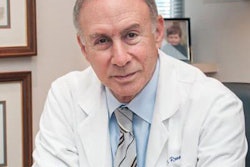PHILADELPHIA - Advancing network technology will strengthen, not diminish, radiology’s role in the future of healthcare, according to Dr. Ronald Arenson, PACS pioneer and keynote speaker at the opening of the 17th annual Symposium for Computer Applications in Radiology.
Arenson, who heads the radiology department at the University of California, San Francisco, chronicled the history of PACS, from modest beginnings in the 1970s to its functional present and presumably bright future, in which medical care will be "driven by radiology."
Today's goal for PACS, he said, is "to get a perfect clinical history and perfect images on your workstation or on the desktop."
Problem-solving a PACS
Arenson’s collection of older slides was worth a million words. In one, a sideburned scientist posed proudly with the box he invented to enable the first fiber-optic connection between a workstation and a mainframe. In another, a large group of patients waited at a hospital registration desk -- before computerized medical records were developed by end-users desperate to speed the process.
"A lot of the early PACS work was done by individuals trying to figure out what we could do to solve problems facing us at the time," he said. "The systems have done a lot to alleviate lines. We often forget the progress that’s been made."
In 1980 Arenson helped found RISC, a nonprofit consortium formed to create a standard radiology information system based on those then in place at major teaching hospitals. The organization merged with SCAR in 1982, the year of the first PACS conference.
The first voice recognition system, the first touchscreen, and the first scheduling and reporting systems soon followed. Other advances came from the defense, space, and petroleum industries. Today, PACS has improved resource utilization, reduced the incidence of lost films and reports, and enabled faster report turnaround and fewer billing errors, he said.
Radiologists well positioned for future growth
Future technological advances will create new diagnostic and therapeutic processes, he said, resulting in a new patient-management scenario. Ultimately, he said, radiologists will assume new roles as informaticists and gatekeepers, becoming the central point of consultation among the paths to patient care.
"We will make decisions about diagnostic work-up and screening techniques, as well as therapeutic direction, and we will then decide which specialists to call and when. Radiologists [will be] in a much different position than they are now. There will be much more patient contact, they will be much more involved in the process of therapeutic care."
Among technologies driving the change, Arenson cited high-resolution teleconferencing and remote videoconferencing as improving the timeliness of consultations, and the Web, which he called the future of information communication.
The HL-7 and DICOM standards have been essential for the development of network image transfer capabilities, and a relatively new communication protocol known as CCOW could be the next major thrust in networking due to its ability to synchronize clinical applications on the desktop, Arenson said.
In addition, the increasing ability to mine data from multiple databases will provide doctors with multiple comparable case studies for comparison. It will improve reporting, decision support, literature searches, ICD-9 coding, quality assurance, and outcomes analysis, he said.
Arenson closed with a caveat, however. "The better we get at imaging, the more likely we are to be targets from some of our colleagues in turf wars, and I’m sure that will continue in the future," he said. "I think those of us who become adept at using these newfangled devices will be in good shape. Those of us who don’t will be out in the street."
By Eric Barnes
AuntMinnie.com staff writer
June 5, 2000
Let AuntMinnie.com know what you think about this story.
Copyright © 2000 AuntMinnie.com


















